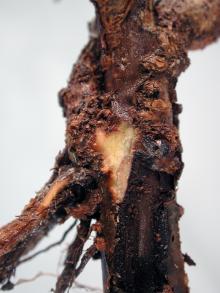See:
Gooseberry and Currant (Ribes spp.) - Armillaria Root Rot
Cause The OSU Plant clinic has received several samples of different root rot problems on both currants and gooseberries. Aside from the fungus Armillaria sp., the following pathogens have been found: Phytophthora spp. and Fusarium most frequently and occasionally Rhizoctonia and Pythium. Black root rot has also been identified a few times.
The ornamental Ribes lobbii was found with both P. cactorum and P. citrophthora in container nurseries.
Symptoms Ribes lobbii root rot - severe wilt and chlorosis symptoms aboveground, with most fine roots completely rotted and larger roots with numerous black lesions below ground. Most affected plants die.
Phytophthora collar rot on gooseberry develops brown, water-soaked lesions at the base of stems resulting in wilting and dying of some bushes.
Cultural control Integrate several cultural and/or chemical tactics to manage these diseases.
- Plant only disease-free plants. Inspect and discard any incoming diseased nursery stock.
- Provide good drainage for plants in beds, fields, or containers. Place containers on gravel beds (4 inches or more deep) to allow drainage.
- Avoid areas of the field or garden where drainage is poor or increase drainage with tiling.
- Do not over-irrigate where the soil is saturated for 48 hr or more. Irrigate deeply and allow drying between irrigations.
- Do not overfertilize with nitrogen.
- Use new pots and avoid reusing pots from a previous crop for propagation. If pots must be reused then wash off all debris and soak in a sanitizing solution or treat with aerated steam for 30 min.
- Use soilless potting mix or steam-treated soil and rooting media. Steam 30 min. at 180°F. Keep field soil out of contact with clean media.
Chemical control Chemical treatment should be preceded by an accurate diagnosis since most of the chemicals are not effective against all possible pathogens. Use these materials preventively only at seeding or transplanting. Do not use to salvage the crop, as treatments are generally ineffective and only help increase the risk of developing resistant fungi.
The Group 4 and Group P7 fungicides used to manage Phytophthora (or Pythium) do not kill this organism. They can only prevent establishment of the organism before it gets into the plant. They can also prevent continued growth if the organism is already inside the plant thereby delaying symptoms that might have developed. Once chemical activity has subsided with time, the organism can resume growth within infected plants.
For Phytophthora:
- Fosphite at 1 to 2 quarts/A. Do not use copper products within 20 days of treatment and do not use spray adjuvants. Group P7 fungicide. 4-hr reentry.
- Orondis Gold at 28 to 55 fl oz/A as a drench, soil-directed spray or through irrigation water. Do not use within 1 day of harvest. Group 4 + 49 fungicide. 48-hr reentry.
- Rampart at 1 to 3 quarts/100 gal water/A. Group P7 fungicide. 4-hr reentry.
- Ridomil Gold SL at 3.6 pints/A applied in 3-ft band centered on the plant row or through drip irrigation system before established plants start growth in spring or at planting for a new field. May be applied up to and including the day of harvest. Group 4 fungicide. 48-hr reentry.
For nursery production, non-food uses for management of Fusarium: All materials have shown inconsistent efficacy from trial to trial.
- Heritage at 1 to 8 oz/100 gal water plus a non-silicone-based wetter sticker. Group 11 fungicide. 4-hr reentry.
- Medallion WDG at 1 to 2 oz/100 gal water. Use with oils or adjuvants may damage plants. Group 12 fungicide. 12-hr reentry.
- Terraguard SC at 4 to 8 fl oz/100 gal water. Group 3 fungicide. 12-hr reentry.
- Thiophanate-methyl-based products. Group 1 fungicides. 12-hr reentry.
- Cleary's 3336 EG at 8 to 16 oz/100 gal water.
- OHP 6672 4.5 F at 7.5 to 20 fl oz/100 gal water.
- Trinity at 8 to 12 fl oz/100 gal water is registered for crown and basal rots. Group 3 fungicide. 12-hr reentry.
- Trionic 4 SC at 8 to 16 fl oz/A. Labeled only for Gooseberry. Do not apply within 7 days of harvest. Group 3 fungicide. 12-hr reentry.
Reference Weiland, J. E., 2015. First report of Phytophthora cactorum and P. citrophthora causing root rot of Ribes lobbii in Oregon. Plant Disease 99:157.


